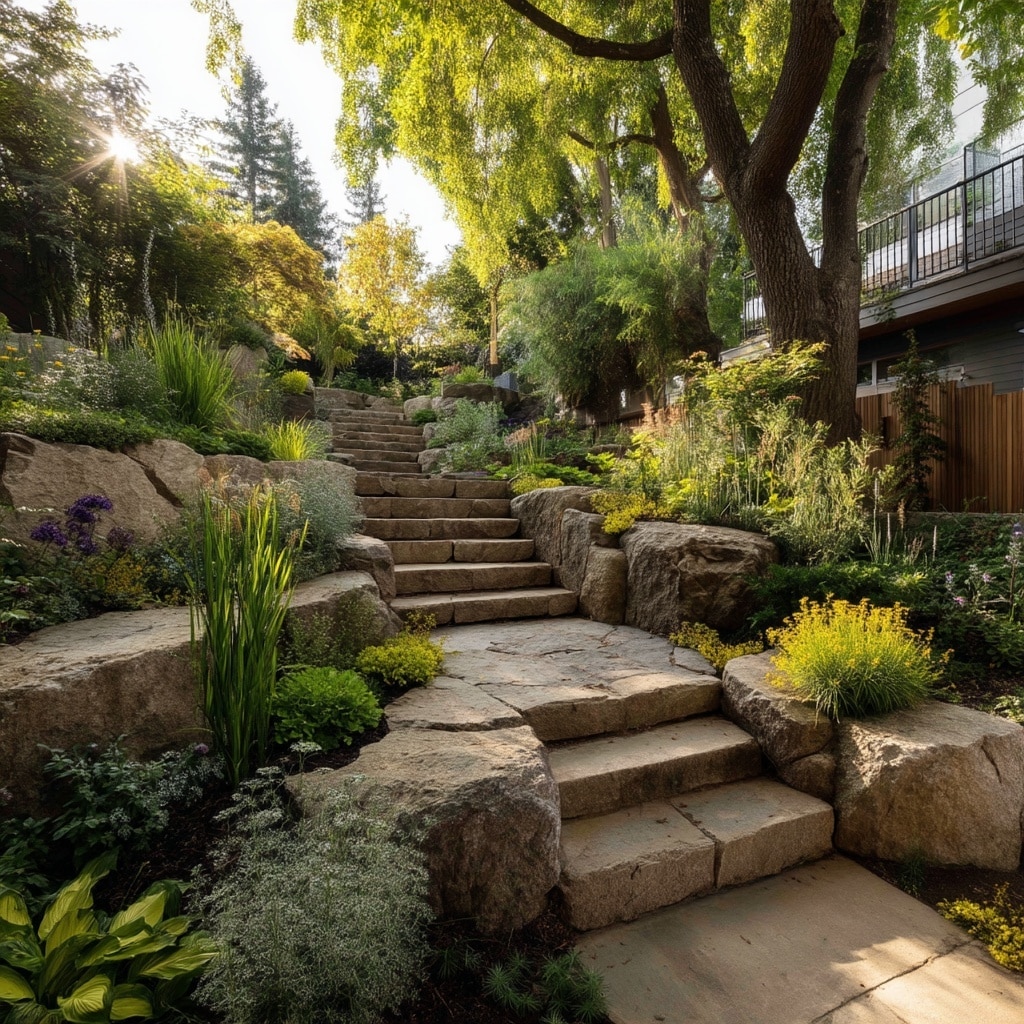Uneven backyard ideas sloped yard solutions can turn even the trickiest outdoor spaces into a stunning and functional retreat. While sloped yards may seem like a design obstacle at first, they actually offer a world of creative landscaping opportunities. With the right approach, you can transform those awkward angles into visually appealing, usable zones for planting, gathering, or relaxing. Whether your backyard has gentle slopes or dramatic hills, smart design and thoughtful features can make the most of every inch.
Table of Contents
Section 2: Terraced Levels and Steps
One of the most practical and visually striking uneven backyard ideas sloped yard homeowners can use is creating terraced levels. This technique involves cutting into the slope to form flat platforms, which are then retained using stone, wood, or concrete walls. These platforms can be transformed into patio areas, vegetable plots, or flower beds, adding depth and structure to the landscape.
Incorporating steps between levels not only makes the space more accessible but also enhances its architectural appeal. Wide stone stairs or rustic wooden steps can blend beautifully with natural surroundings. For a cohesive look, consider matching the materials of your retaining walls and steps.
Pro Tips:
- Use gravel or crushed stone behind retaining walls for proper drainage.
- Add soft lighting along steps to improve nighttime visibility.
- Integrate low-maintenance plants along the edges of terraces to soften hardscape lines.
This layered design not only combats erosion but also makes the most of your backyard’s vertical potential.
Section 3: Angled Raised Garden Beds
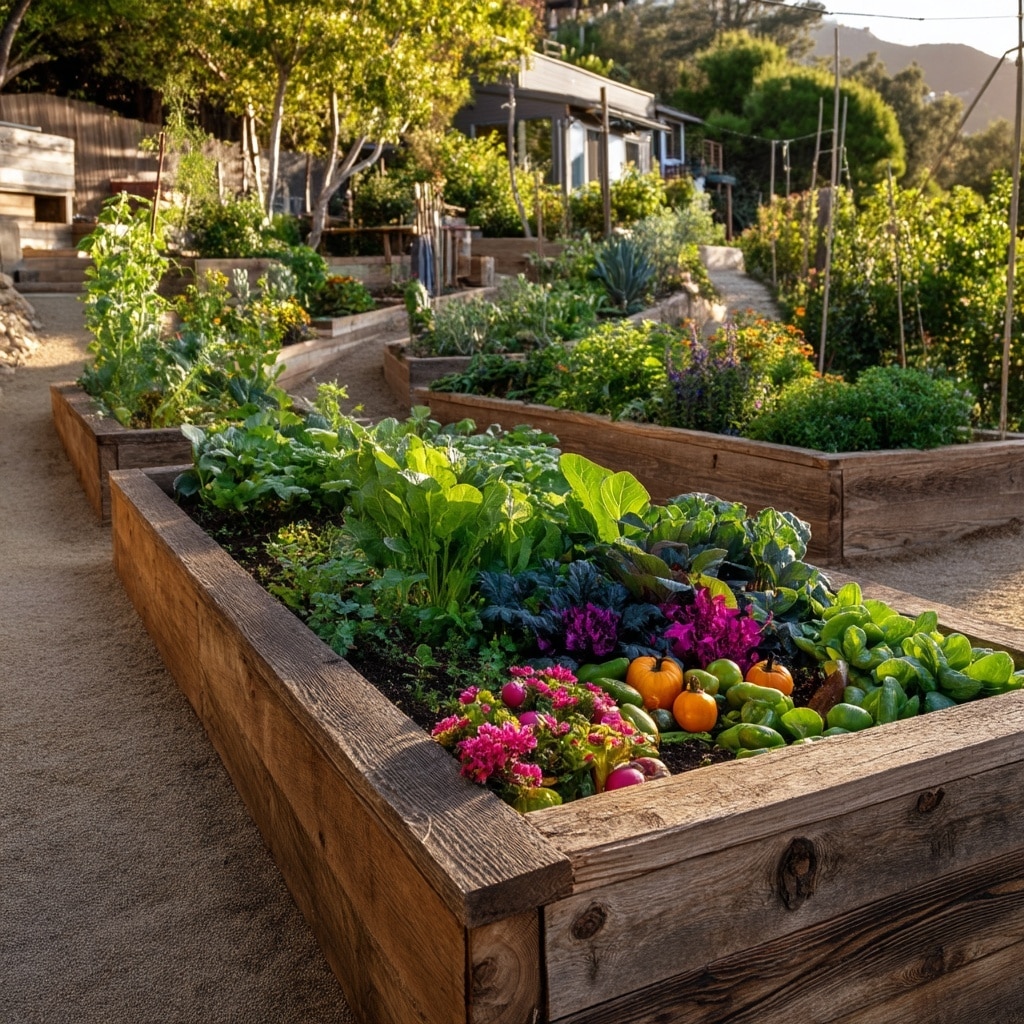
When thinking through uneven backyard ideas sloped yard owners often overlook how raised garden beds can be creatively adapted to the landscape’s contours. Instead of trying to level the entire space, consider working with the slope by installing raised beds at an angle.
These beds can follow the natural incline of your yard, turning awkward slopes into visually dynamic and productive planting zones. Whether you’re growing herbs, vegetables, or ornamentals, angled raised beds provide good drainage and are easier to maintain than traditional ground-level planting on uneven terrain.
Design Tips:
- Stagger the beds to create a cascading effect down the slope.
- Use rot-resistant wood or metal edging for durability.
- Plant vertically to save space — think trellises, cages, and climbing vines.
You can even mix and match plant types — vibrant flowers in one bed, leafy greens in another — to bring color and texture to your slope. It’s a smart way to introduce both beauty and utility into your uneven backyard.
Section 4: Pathways That Guide and Define

Pathways are a game-changing feature when planning uneven backyard ideas sloped yard transformations. Not only do they make your space more accessible, but they also guide the eye and break up large slopes into visually appealing zones.
You don’t have to stick with just one material — combining natural stone, pavers, or gravel can add texture and charm while also being practical for different slope grades. For instance, flat areas may be perfect for wide paver paths, while steeper inclines benefit from more rugged materials like flagstone or even embedded timber steps.
Smart Pathway Ideas:
- Use curved paths to follow the natural lay of the land.
- Add mulch or crushed granite for affordable, earth-toned trails.
- Incorporate edging to keep paths neat and prevent material from washing out.
To enhance the experience, line your pathways with low-growing plants, solar lights, or decorative rocks. These paths can act as both functional walkways and design elements, subtly tying your entire backyard together.
Section 5: Stair Solutions for Steeper Slopes

When it comes to uneven backyard ideas sloped yard situations that include steep gradients, stairs are more than just helpful—they’re essential. They provide safe, direct access between elevation changes and can serve as a strong visual centerpiece in your landscape design.
Depending on your yard’s style and budget, you can choose from natural stone steps, wooden sleepers, or even precast concrete blocks. To soften the look, nestle stairs into surrounding plantings or flank them with decorative rocks and groundcovers.
Design Considerations:
- Keep step height consistent to prevent tripping.
- Use railings or side walls for added safety on taller slopes.
- Integrate landings every 4–6 steps for visual balance and easier navigation.
Beyond function, stairs can elevate your backyard’s aesthetic, especially when paired with lighting and landscaping features like ferns, ornamental grasses, or low shrubs. They help tie all levels of the space together while making it accessible and inviting.
Section 6: Water Features That Flow With the Land
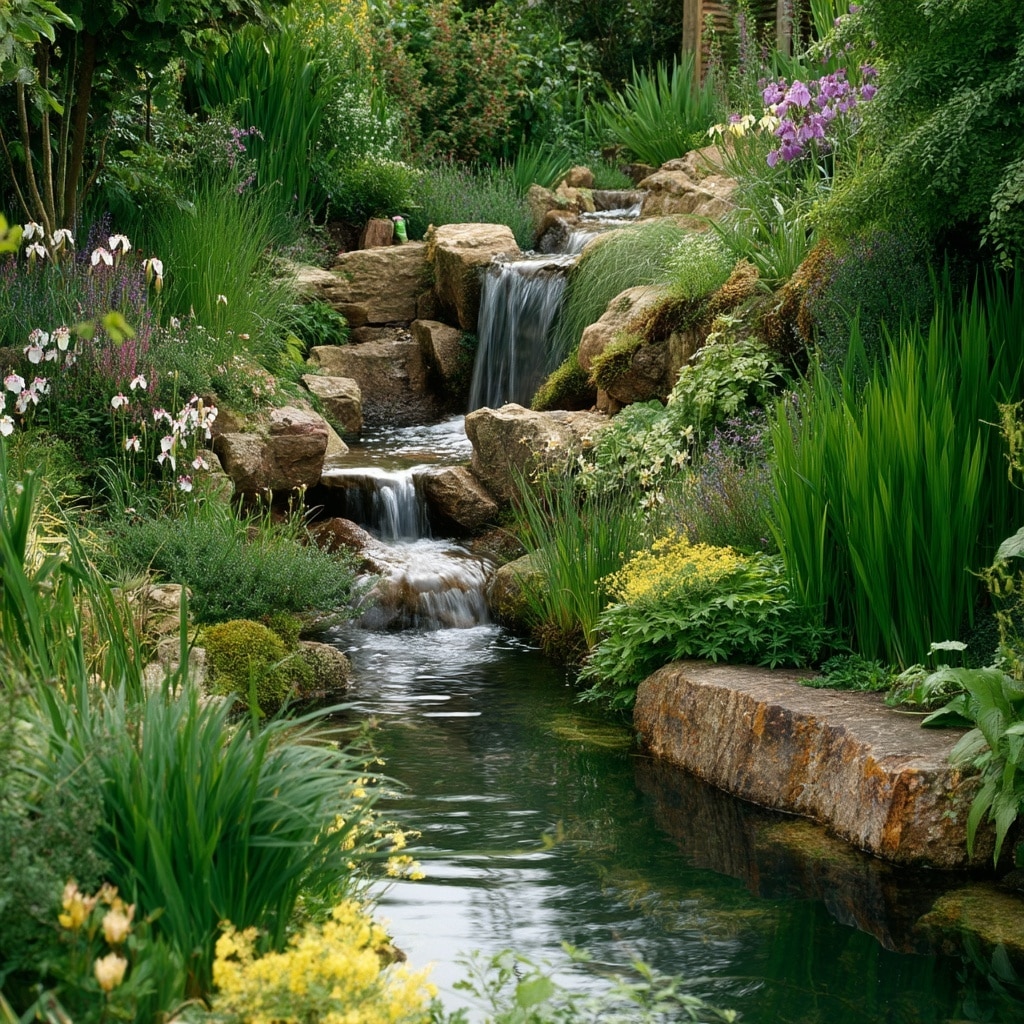
One of the most visually soothing uneven backyard ideas sloped yard homeowners can embrace is adding a water feature that naturally follows the flow of the terrain. Rather than fight gravity, let it work in your favor by installing a cascading waterfall, stream, or tiered fountain.
Sloped yards are ideal for multi-level water features, where each drop or level can be visually defined with stones, plants, or even small retaining ledges. Not only does this approach add calming movement and sound to your space, but it also helps mask imperfections in grading or hardscape transitions.
Water Feature Tips:
- Choose a recirculating system to conserve water and reduce maintenance.
- Integrate aquatic plants for a natural look and added ecosystem support.
- Frame the feature with rocks or drought-tolerant plants to blend it into the landscape.
Whether it’s a simple bubbling basin or a full pond with a waterfall, water features create a focal point that distracts from unevenness and enhances the serenity of your garden.
Section 7: Patio Ideas Using Tumbled Pavers
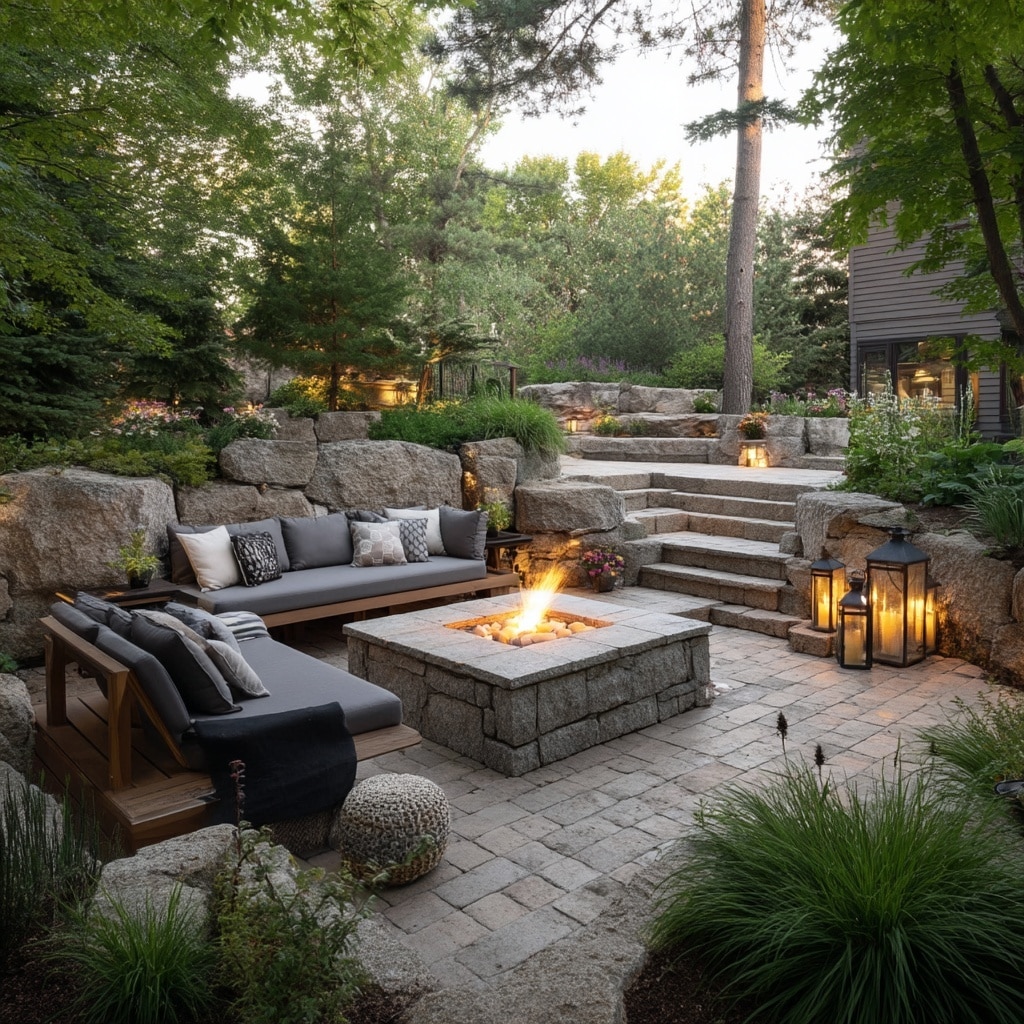
If you’re looking for uneven backyard ideas sloped yard challenges shouldn’t stop you from enjoying a cozy patio. Tumbled pavers offer an excellent solution for building level surfaces on uneven ground while maintaining a rustic, natural look.
These pavers are intentionally weathered or “tumbled” to give them a softer, more aged appearance — perfect for blending into natural landscapes. What makes them ideal for sloped yards is their flexibility; they can be dry-laid over compacted gravel to follow mild slopes or used atop a leveled base supported by small retaining walls.
Patio Planning Tips:
- Create segmented zones using different paver patterns.
- Use permeable pavers for better drainage on inclined surfaces.
- Edge your patio with native plants or mulch beds to soften transitions.
Whether you want a small café-style nook or a large seating area with a fire pit, tumbled pavers make it possible to build a durable, charming patio without fighting the slope.
Section 8: Tiered Flower Beds for Color and Structure
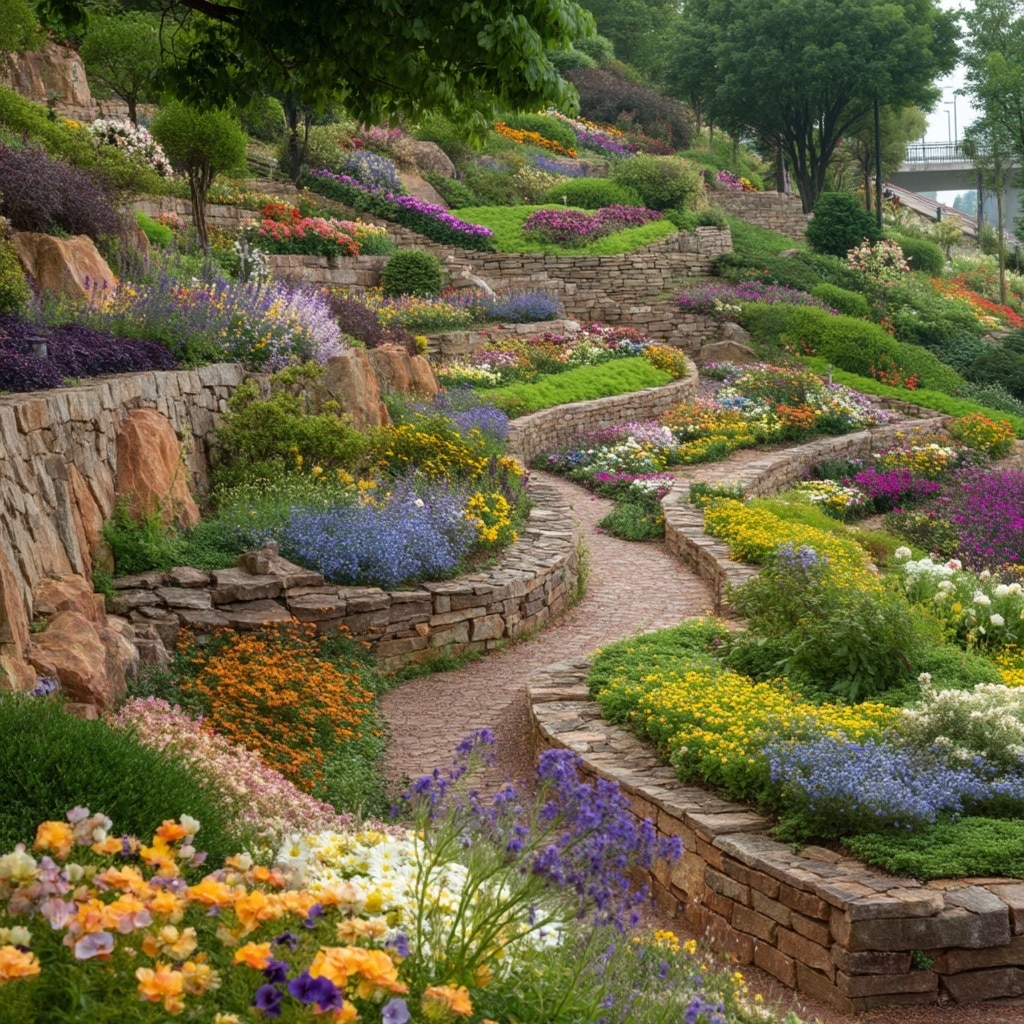
When brainstorming uneven backyard ideas sloped yard gardeners often find that tiered flower beds are the perfect way to add vibrant color while also giving structure to a challenging landscape. By dividing a slope into layers using retaining walls, landscape timbers, or stone borders, you create multiple flat planting areas that are easier to manage and visually appealing.
Each level can be planted with a different color scheme or plant type to create contrast and rhythm across the slope. Consider low-growing groundcovers on upper tiers, with fuller, taller plants cascading down the lower levels to enhance depth and flow.
Tips for Stunning Tiered Beds:
- Use native or drought-resistant plants to minimize maintenance.
- Incorporate mulch or stone between tiers to control erosion.
- Blend textures — mix leafy greens with spiky grasses and flowering perennials.
In addition to boosting curb appeal, tiered flower beds also reduce soil runoff and make planting and maintenance more accessible, especially on steeper grades.
Conclusion
Transforming a sloped yard doesn’t have to be overwhelming. With thoughtful planning and creative design, you can turn those challenging elevations into unique highlights of your outdoor space. From terraced levels and angled garden beds to flowing water features and charming patios, these uneven backyard ideas sloped yard solutions prove that any terrain has potential.
Whether you’re going for practicality, beauty, or both, the key is to work with the natural contours rather than against them. Start small, build in layers, and watch your backyard evolve into a stunning, functional retreat.

